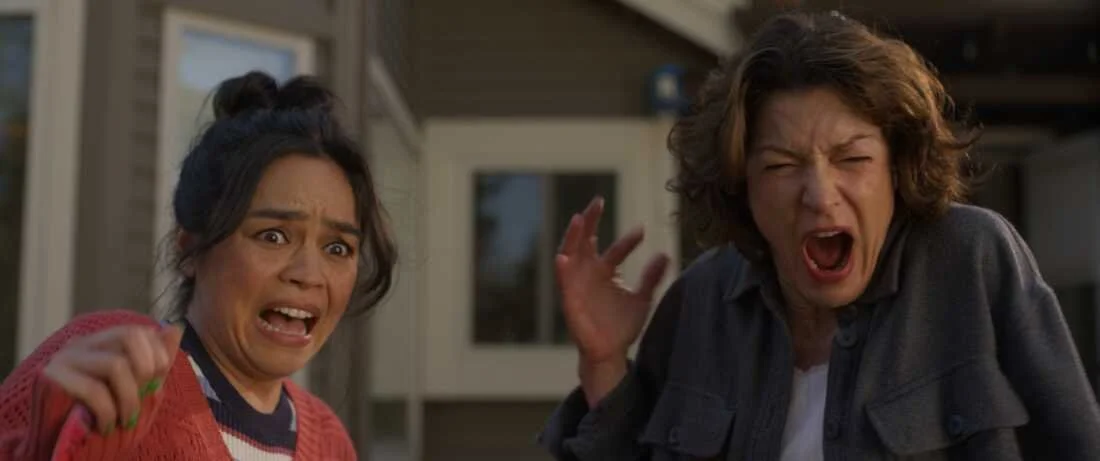because in a moment, it could all *boom*
Editor-in-Chief Hannah Jade’s unserious review of the equally unserious film, Final Destination: Bloodlines (2025), the final installation of the beloved millennial series which features no apparent killer or supernatural apparition.
Co-directors Zach Lipovsky and Adam Stein definitely had too much fun making Final Destination: Bloodlines (2025). For one, they shared that one of the most elaborate parts of making the film was getting retired stuntwoman Yvette Ferguson to perform the role of a woman who is accidentally set on fire as she tries to escape the top floor of a collapsing building. As a fan of the series, I was excited to watch the much anticipated reiteration of the mysterious franchise’s seemingly simple formula: Premonition, then freak accident upon freak accident until everyone is dead. Clearly, nobody is watching this film to find out how the movie ends, but rather to satiate our morbid appetites for violence.
Final Destination: Bloodlines, which runs for 110 minutes, begins with a horrendous scene of a young Iris experiencing a premonition that everyone in the restaurant of the Sky View Tower will die in various freak accidents. Although Iris escapes, her traumatic encounter with Death dramatically heightens her instinct to survive. The Sky View Tower, which was built almost half a year before its expected completion, hosts a glitzy opening night celebration and prefaces the backdrop of Paul’s marriage proposal to Iris. The first 20 minutes are explored through the limited third-person perspective of Iris, who notices many other preliminary signs of the building’s collapse. Johnny Cash’s song “Ring of Fire” echoes outside the lobby and the camera closes up on a singular coin which later becomes Death’s chosen instrument to orchestrate the reality of Iris’ premonition. Even from the get-go, Iris’ unsettled demeanour manifests in her shifting eyes and apparent fear of heights when she looks down at the city from the glass floors of the Sky View. Albeit simple, these elements drove the chilling anticipation of death further up my spine, and yet I felt too squeamish to watch the rest of the film which features Iris’ descendants finding ways to survive Death.
Having watched the preceding films as a teenager, I found Bloodlines to be campier than expected due to the directors’ exaggeration of painfully generic character tropes (e.g. the happy-go-lucky father, the estranged mother, the “crazy” aunt, the “emo” cousin) and bringing them to life by feeding them the most stereotypical dialogue which audiences have most definitely heard before in other horror films and thrillers. These techniques have always been key thematic concerns in the other Final Destination films but Bloodlines’ humorous jargon and behaviour feel a lot closer to us now, likely because the film embodies the contemporariness of our time.
The film followed a rather predictable plotline which embodied equally predictable dialogue from the characters. Nevertheless, the directors’ creativity shone through in certain death sequences, such as the MRI machine scene where Erik and Bobby die after being sucked into the machine and crushed to death. Other than making these violent deaths so visceral on screen (Bloodlines is the first film in the series to be shot in IMax), the film also embodies a self-reflexive approach to its filmic identity in which homage is paid to its predecessors. For instance, towards the end of the film, the same coin used by Death gets lodged in a train track, causing a train to derail and crash through a suburban neighbourhood and kill Iris’ granddaughter Stefani and her younger brother Charlie. The train was also a crucial motif representing Death’s arrival in the third instalment, which ends with the last character being killed in an underground train derailment. Bloodlines briefly features a book detailing various ways in which Death may arrive and methods to cheat Death, further reinforcing the obvious that everyone will die at the end of the film.
What then becomes the purpose of watching such a film? If not for unearthing our depraved desires for on-screen gore and violence, perhaps it is then for the reminder that Death becomes us all eventually. It is the reality that terror can strike at any moment just like that, and we would never see it coming. When making Bloodlines, Stein explores the question: “What are the everyday experiences or everyday objects or everyday feelings that we can ruin for people?” while speaking to The Guardian during the production of the upcoming film Freaks Underground which is the sequel to Freaks (2018). For some viewers, the question certainly hits the nail on the head. But after reading the reviews by some Gen Zs on Letterboxd, Bloodlines is another base to turn the prospect of death into a comical spectacle that exhibits dramatic flair rather than fear. A quick scan of the top reviews shows users joking about how getting a job or having to hang around distant cousins are much worse experiences than dying. I owe these attitudes to our jadedness with how much more exhausting every day becomes in today’s climate and economy.
Sometimes, it takes films like Bloodlines to make us realise our conditions of existence. In laughing at ourselves, we may also be spurred into becoming more deliberate in the decisions that we make, to make every day truly count.
Although Bloodlines concludes the saga, I would definitely pay to watch its future reboot (Hollywood make it happen pls)— Final Destination: It Girls as pitched by none other than BRAT-ty princess of pop, Charli XCX because “they’re hot, they’re cursed and they deserve to die.”



